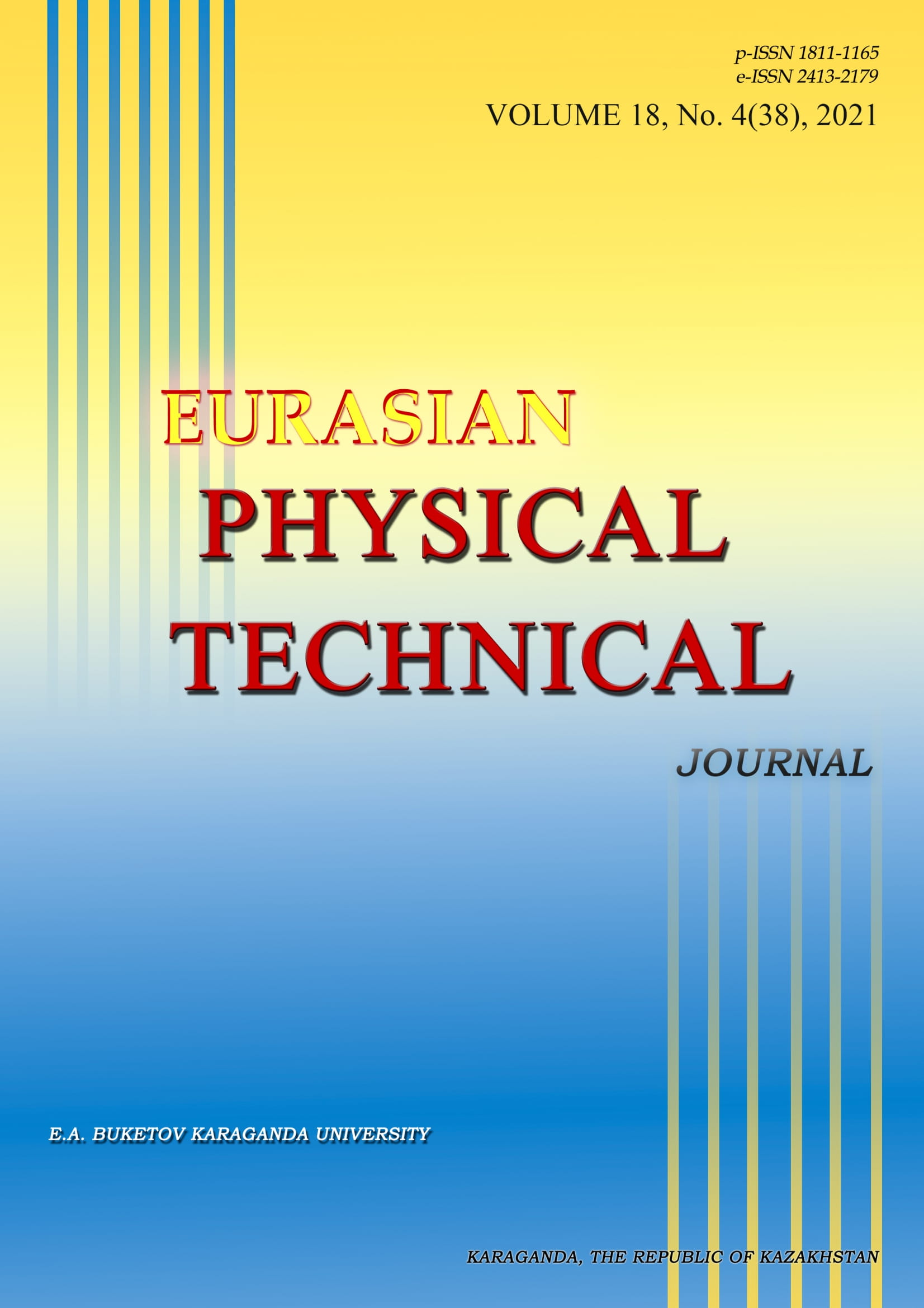"STUDY OF THE EFFECT OF THE CHANGE IN THE APPLIED POTENTIAL DIFFERENCE ON THE PROPERTIES OF CdSe: Ni THIN FILMS "
DOI:
https://doi.org/10.31489/2021No4/20-28Keywords:
doping, CdSe, photocatalysis, thin films, reaction rateAbstract
This work is devoted to the study of the efficiency of using the effect of nickel doping of thin films based on CdSe with the possibility of varying the structural and optical properties due to a change in the phase composition of the films. The method of electrochemical reduction of metal ions from aqueous solutions of electrolytes was chosen as a method for obtaining films. The variation of the applied potential difference was used to produce films with different characteristics. To characterize the properties and dynamics of their changes, methods of atomic force microscopy, energy dispersion analysis and X-ray diffraction were chosen. The strength mechanical properties of the films were studied using the indentation method. During experiments conducted dependencies of changes of structural, optical, strength characteristics of synthesized films depending on production conditions are obtained. Photocatalytic tests to determine the rate and efficiency of decomposition of the Rodamine B organic dye showed that films in the composition of which the NiSe phase prevails have the greatest potential for use as photocatalysts.
References
"1 Liu Hao, et al. Enhanced photocatalytic capability of zinc ferrite nanotube arrays decorated with gold nanoparticles for visible light-driven photodegradation of rhodamine B. Journal of materials science. 2016, Vol. 51, No.12, pp. 5872 – 5879.
Alshammari A., Bagabas A., and Assulami M. Photodegradation of rhodamine B over semiconductor supported gold nanoparticles: the effect of semiconductor support identity. Arabian Journal of Chemistry. 2019, Vol. 12, No. 7, pp. 1406 – 1412.
Sangami G., Dharmaraj N. UV–visible spectroscopic estimation of photo-degradation of rhodamine-B dye using tin (IV) oxide nanoparticles. Spectrochimica Acta Part A: Molecular and Biomolecular Spectroscopy. 2012, Vol.97, pp. 847 – 852.
Parvaz S., Rabbani M., Rahimi M. Fabrication of novel magnetic ZnO hollow spheres/pumice nanocomposites for photodegradation of Rhodamine B under visible light irradiation. Materials Science and Engineering: B. 2021, Vol 263 pp. 114863.
Kozlovskiy A.L., Alina A., Zdorovets M.V. Study of the effect of ion irradiation on increasing the photocatalytic activity of WO 3 microparticles. Journal of Materials Science: Materials in Electronics. 2021, Vol. 32, No. 3, pp. 3863 – 3877.
Kozlovskiy A., et al. The study of the applicability of ionizing radiation to increase the photocatalytic activity of TiO 2 thin films. Journal of Nanostructure in Chemistry. 2020, Vol. 10, No. 4, pp. 331 – 346.
He M. Q., et al. Synthesis of molecularly imprinted polypyrrole/titanium dioxide nanocomposites and its selective photocatalytic degradation of rhodamine B under visible light irradiation. Express Polymer Letters. 2014, Vol 8, No. 11, pp 850–861.
Larowska D. et al. Graphene oxide functionalized with cationic porphyrins as materials for the photodegradation of rhodamine B. The Journal of Physical Chemistry C. 2020, Vol. 124, No. 29, pp. 15769-15780.
Jadhav S.A., et al. Magneto-structural and photocatalytic behavior of mixed Ni–Zn nano-spinel ferrites: visible light-enabled active photodegradation of rhodamine B. Journal of Materials Science: Materials in Electronics. 2020, Vol. 31, pp. 11352-11365.
Fattahimoghaddam H., Mahvelati-Shamsabadi T., Lee B.-K. Efficient photodegradation of rhodamine B and tetracycline over robust and green g-C3N4 nanostructures: supramolecular design. Journal of Hazardous Materials. 2020, Vol. 403, pp. 123703.
Il’chuk, G. A., et al. Peculiarities of the optical and energy properties of thin CdSe films. Optics and spectroscopy. 2020, Vol. 128, No. 1 pp. 49-56.
Milonakou-Koufoudaki, K., et al. Natural dyes in hybrid chalcogenide multi-layer thin films. Bulletin of Materials Science. 2020, Vol. 43, No. 1, pp. 1 - 11.
Hamann, Kathryn R., et al. Optically tunable mesoscale CdSe morphologies via inorganic phototropic growth. Journal of Materials Chemistry C. 2020, Vol. 8, No. 36, pp. 12412-12417.
Chauhan P., et al. Superior electrochemical activity of CdSe thin film by chromium substitutional doping. Journal of Alloys and Compounds. 2021, Vol. 862, pp. 158016.
Shelke N.T., Karle S.C., Karche B.R.. Photoresponse properties of CdSe thin film photodetector. Journal of Materials Science: Materials in Electronics. 2020, Vol. 31, No. 18, pp. 15061-15069.
Lohitha B., Thanikaikarasan S., Roji Marjorie S. Growth and characterization of CdS and Fe doped CdS thin films through electrochemical route. Materials Today: Proceedings. 2020, Vol. 33, pp. 3068-3071.
Patil N.M., et al. Structural, optical and electrical properties of spray-deposited Fe-doped nanocrystalline ZnS0.2Se0.8 thin films. Phase Transitions. 2021, Vol. 94, No. 6–8, pp. 493–510.
Han Chong et al. Carbon Dots Doped with Ni(OH)2 as Thin-Film Electrodes for Supercapacitors."" ACS Applied Nano Materials. 2020, Vol. 3, No.12, pp. 12106-12114.
Abdulwahab A.M., Asma'a Ahmed A.L.-A., Ahmed A.A.A. Influence of Ni-Co dual doping on structural and optical properties of CdSe thin films prepared by chemical bath deposition method. Optik. 2021, Vol. 236, pp. 166659.
Tan, Wenyu, et al. Nucleation and growth mechanisms of an electrodeposited Ni–Se–Cu coating on nickel foam. Journal of Colloid and Interface Science. 2021, Vol. 600, pp. 492-502.
Omarova, A., et al. Study of the influence of synthesis conditions on stoichiometry and the properties of nanostructured CdSe thin films. Journal of Materials Science: Materials in Electronics. 2020, Vol. 31, No. 15, pp. 12756-12764.
Alasvand A., Kafashan H. Investigation the effect of Pb incorporation on the surface characterizations of electrodeposited CdSe nanostructures. Journal of Alloys and Compounds. 2020, Vol. 817, pp. 152711.
Ayal, A.K., et al. Sensitization of TiO2 nanotube arrays photoelectrode via homogeneous distribution of CdSe nanoparticles by electrodeposition techniques. Journal of Physics and Chemistry of Solids. 2020, Vol. 153, pp. 110006.
Shaikh A.V., et al. Electrodeposition of n-CdSe/p-Cu2Se heterojunction solar cells. Engineered Science. 2020, Vol. 13, pp. 79-86.
Saha S., et al. Electrodeposition Fabrication of Chalcogenide Thin Films for Photovoltaic Applications. Electrochem. 2020, Vol. 1, No.3, pp. 286-321.
Gullu H.H., et al. Temperature effects on optical characteristics of CdSe thin films. Materials Science in Semiconductor Processing. 2021, Vol. 123, pp. 105559.
Erturk K., et al. Investigation of structural, spectral, optical and nonlinear optical properties of nanocrystal CdS: Electrodeposition and Quantum Mechanical Studies. Optik. 2021, Vol. 243, pp. 167469.
Thanikaikarasan S., et al. Physical, chemical and optical properties of CdSe and CdSe: Zn thin films obtained through low cost electrochemical route. Materials Today: Proceedings. 2020, Vol. 21, pp. 73-77.
Zhang Y., et al. Alkaline electrolyte: toward high-quality CdTe films with the assistance of strong complexing agent and organic base. CrystEngComm. 2018, Vol. 20, No. 1, pp. 8-11.
Zyoud A., et al. Electrochemically and chemically deposited polycrystalline CdSe electrodes with high photoelectrochemical performance by recycling from waste films. Materials Science in Semiconductor Processing. 2020, Vol. 107, pp. 104852.
"















